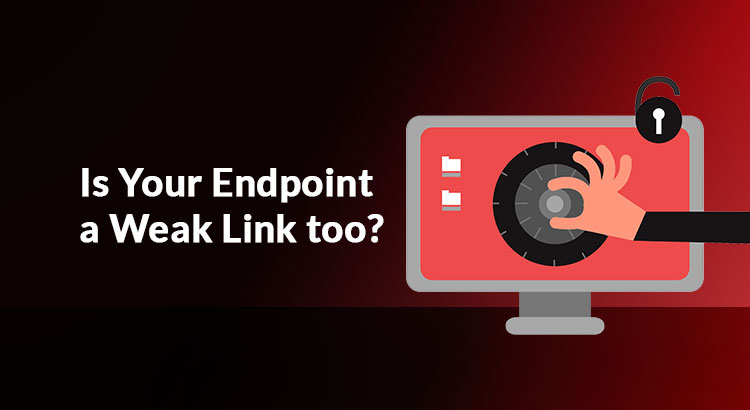Endpoint security, in essence, is the regimen of restraining any form of internal access in an organizational endpoint infrastructure. As the name implies, the discipline is primarily implemented upon end-user devices, such as laptops, desktops, and smartphones.
But, how does it work in a professional environment?
The endpoints are usually utilized as an entrée to any network and create different points of entry. An individual with malicious intent can exploit them to gain critical information from an organization and wreak havoc on their reputation.
An endpoint security tool protects such entry points through encryptions and prevents malware programs from accessing delicate details. By ensuring endpoint compliance with your data security structure, you can gain superior control over everything.
Why Should You Worry About Your Endpoint Devices?
In today’s digitized world, almost everyone uses either a smartphone or a laptop. As per a report, 6.4 million people are using mobile in 2021 (a 5.3% increase since 2020). However, the worrying part is that each of them has an entry point.
Thus, it becomes easier for hackers to exploit the severe lack of security and extract personal information from an endpoint device. Endpoint attacks are reasonably prevalent as well. In 2020, the number of such cyber-threat increased by almost 68% than the previous year.
So, if you have any vital information on your devices, they may get stolen at any time. However, an endpoint security system can put an end to such worrisome circumstances.
An endpoint security infrastructure is built on two aspects – detecting a suspicious end-user and preventing unauthorized access.
With it, you can not only control your endpoint access but also monitor malicious activities on your network. You may block a user of the same device if you feel they are attempting to input malware into your endpoint devices.
The endpoint devices of an organization (or an individual) are considered the weakest link in the networking cosmos. Therefore, ensuring its safety and security will be beneficial in a long-term scenario.
Integral Features of Endpoint Security
As per RiskIQ, organizations all over the world experience more than 350 cyber-threats every minute. Hence, if you want to make your network, make sure to opt for an endpoint security tool with the following features.
- An endpoint security tool must be capable of detecting a malicious e-mail and terminate it instantly. This way, the commonality of phishing can be countered efficiently.
- It should protect against zero-day (a type of difficult-to-identify flaw found in software during development) and any other further exploits.
- The system needs to offer alerts when something malicious enters your endpoint infrastructure. Besides, it must provide a daily report with regards to questionable activities as well.
- An endpoint security system can also scrutinize the outgoing and incoming traffic of your network system. Conjunctively, it must offer browser protection to save you from downloading something malicious.
- It needs to have a DLP system integrated into it as well. This way, the software program can access violations caused by your employees and prevent unintentional/intentional data loss.
- Availing endpoint security with implemented machine learning can analyzing good/bad files much more manageable. It may also help the module to block malware variants before they can damage your endpoint devices. Machine learning may also help in monitoring your employee’s behavior and find the culprit beforehand.
- An endpoint security system should be flexible to be deployed as per the organization’s requirements. Finding a tool, which offers both cloud and on-premise security, will be ideal for any corporation.
- Finally, the software programs need to be integration-friendly as well. This way, it will be easier for the system to communicate with the other security tools in your organization. Through proper incorporation, endpoint security can also prevent intrusion, create an active directory, and monitor your network.
Endpoint Security and Other Cybersecurity Systems
An endpoint security system can only do so much in a vast network environment. Therefore, you need to pair it up with at least one or two other protective infrastructures to maximize its potential. Let’s learn more in this regard through examples.
Endpoint Security and UBA (User Behavior Analytics)
In some cases, the threat of exploiting the weakness of your endpoint devices is caused by your end-users. Hence, if you know about those individuals who conduct suspicious activities, you can avert the worst conclusion efficiently.
However, the catch is that an endpoint security system alone cannot perceive user behavior entirely. So, you will need to use a UBA tool to maximize its efficiency in this respect. Here’s how User Behavior Analytics can be ideal for your cause –
o Allows you to perform data profiling and detecting anomalies
o Collects insights on the malicious IT profiles (can be implemented on the endpoint security system to block them before any demurrage)
o Offers superior analytics capabilities and quicker risk detection
o Lowers the risk of data abuse or misuse in an organizational environment
Endpoint Security and EPM (Endpoint Privilege Management)
Using EPM with a dedicated endpoint security system will improve the latter’s performance in several aspects. For instance, it can help in increasing the overall security efficiency during a privileged task. This way, you won’t be bothered with malware programs that may cause hindrance to your work.
Additionally, it will be easier for you to create a role-based access infrastructure in your organization. By doing so, you may not have to create unique profiling for all of your employees. Finally, you can also use the dashboard of EPM conjunctively with endpoint security to get a real-time view of the privileged sessions.
Conclusion
In truth, adding an endpoint security system alongside other cybersecurity programs might not seem like a cost-effective decision at first. However, it can save you from data theft and severe network breakdown, which may cost you even more. So, a business should implement and integrate a dedicated endpoint security tool in their organization’s infrastructure.

